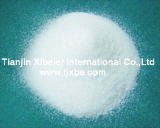Sodium Formate
-
- Category :
Organic chemicals and Derivatives
- CAS NO : 141-53-7
- EC NO : 205-488-0
- Molecular Formula : CHNaO2
- Main Specifications : HCOONa
- Synonyms : Sodiumformatehydrate;Formic acid sodium salt;formic acid sodium sigmaultra;formic acid sodium;FORMIC ACID, NA SALT;Mravencan sodny;Formic acid, sodium salt; Salachlor;Formic acid,Na salt;Formax;
Package: 25kg/1000kg net PP bag with PE liner
Uses : Dyeing,printing of fabric,leather tanning,chrome electroplating process,paper industry as anti oxidants,etc.
Molecular Structure:

Product description:
Product Name: Sodium formate
Chemical Formula: HCOON. 2H2O
Molecular Weight: 68
CAS No: 141-53-7
HS Code: 29151200
Boiling Point: 360 deg C
Melting Point: 255 deg C
Physical Properties: with water absorbing performance and slight formic acid odour, soluble in water, sparingly soluble in alcohols, and insoluble in organic solvents.
Packing: Packined in 25kg net PP bag, 25MT in a 20'FCL.
Usage:
1) Raw material
Sodium formate chemically reduces other components by donating an electron or electrons. Formic acid and oxalic acid are prepared from sodium formate. Sodium formate is used in the manufacture of sodium hydrosulfite, a common reductive bleaching chemical.
2) Reductive bleaching agent
Sodium formate is used to improve the brightness and color in dyeing/printing fabrics and paper.
3) Tanning of leather
Sodium formate stabilize the chromium, resulting in better leather quality. It is used for better penetration and tanning time reducing
4) Deicing chemical
Sodium formate is less corrosive and undergoes fast melting action relative to other deicing chemicals.
5) Buffering agent
Sodium formate improves both desulfurization efficiency and increasing lime absorbent utilization.
6) Animal feed additive
Sodium formate is an efficient feed additive as it improve digestibility.
7) Sodium formate is also used in liquid detergent as a builder or an enzyme stabilizer. It is used in dyeing, in electroplating, in silage preservation
Transportation and Storage: Preventing exposure to moisture in the storage and transportation. If lumping occurs, the properties of the product will not change and it can be used normally after being pulverized.
